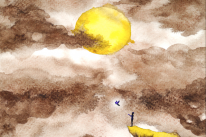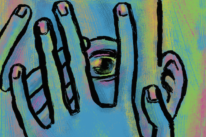
“F-E-A-R has two meanings: ‘Forget Everything And Run’ or ‘Face Everything And Rise.’ The choice is yours.” ~Zig Ziglar
“Face everything and rise.” Good advice, but how do we do that when we feel incapable? Well, I recently discovered an effective tool that we can rely on whenever anxiety comes for a visit. And I just can’t describe how grateful I am for that discovery!
For over ten years I’ve been suffering from general and social anxiety. People who don’t know me well would be surprised to hear that, since I became a master of hiding my feelings. But when I found myself in certain social situations and could not hide those feelings anymore, they would erupt and turn into panic attack episodes, which caused me a tremendous amount of suffering.
From the outside, one could say my life was as good as it could be. I have supportive parents, a loving girlfriend, a good, steady job, and a house. Unfortunately, my only brother and I are not in touch, but I guess this can happen in the best of families.
I became a prisoner of my own anxiety. My fear generated physical and emotions symptoms, which generated more fear; it felt like an endless cycle. The weight on my back was so heavy that, despite accepting life, I had lost faith in it.
After trying several types of treatments, I finally discovered meditation and then went on a ten-day Vipassana retreat. I decided to do this for a few reasons:
- Evidence shows that this technique has helped prisoners, and I guessed that they had even bigger issues than me. At the start of the retreat, during an introductory event, they showed a movie about how the Indian government introduced Vipassana in jails due to its tremendously effective results.
- The retreat was donation based, so I knew that no one was taking advantage of my weakness.
- Deep inside, I knew that I was the person who could best help me. I wanted to learn about myself and understand what was bothering me so much. And the best way of learning, in this case and in general, is by experiencing
In Vipassana, you learn how to disconnect from the outside world and to connect to your inner world—to experience your sensations and understand that, either good or bad, they will eventually pass. You learn how to become the observer rather than the participant, so you stop reacting to sensations and, therefore, learn to relax.
Why sensations? Because everything we experience in life through our six senses—sight, hearing, taste, smell, touch, and the thinking mind—causes different types of sensations in our bodies, which we automatically label as “good” or “bad.”
For example, hearing the birds singing in the morning will cause good sensations. On the other hand, hearing the barking of angry dogs would probably cause bad sensations. And those sensations instinctively generate a reaction—one of craving and clinging (we don’t want the beautiful melody to end) or aversion and hatred (we wish that the scary barking would stop).
We fall in the trap of getting attached to the sensations, and over and over generate a reaction. Reactions of all types: fear, anger, sadness, judging, dependency on things or other people, hurting. All those bring us suffering.
And here’s where Vipassana can help us. The whole technique is built on three types of meditation:
1. Anapana (observing respiration)
Observe the sensations in the nostrils area; breathe in and breathe out. Soft or strong, short or long, calm or agitated—it doesn’t matter, and we don’t need to control it; just observe it and let it be the way it is moment by moment.
It’s been said that respiration is the bridge between our bodies and mind, the path to our unconscious mind. By observing it, we can reach its deepest levels and turn agitation into calmness.
Use Anapana as your shield against anxiety! It works. It allows you to consciously take a breath when you drown in the sea of anxiety, and you can do it anytime you need it. Bring your mind back to focus and calm it down!
2. Vipassana (observing sensations from head to feet and vice versa)
Once we are trained to observe our respiration, we are ready to start observing other areas of our bodies. So we start from the head and go down to the feet, through every single part of the body. Side by side and eventually also from feet to head.
Sensation will vary from part to part; they can be soft or strong, good or bad. But whatever they are, the common thing between them is that they will arise and then eventually pass. By understanding that, we can stop reacting to the sensations, keep our focus, and become the observer. We learn that through experiencing.
3. Metta (wishing the end of suffering to every living creature)
When we reach the point of inner peace, we become ready to share this peace, love, and harmony with everyone around us.
—
No doubt, Vipassana was the biggest present I could give myself, and it’s changing my life. I feel I have been reborn. The benefits are not just limited to the way I deal with anxiety now. It’s actually way more than that.
As a result:
- I have gained the ability to focus more on the present, and less on the past or future. As a result, I enjoy more of what I’m doing at every single moment.
- I’m more accepting and tolerant of others, with no judgment. I’ve started donating and volunteering. I understand love better and am much better able to show it to my dearest ones.
- I’m more efficient, able to make choices quickly and stick with them (in work and life in general). I’m learning to enjoy but not to get attached.
My parents told me the other day that I’ve started to smile with my eyes again, something I used to do when I was a kid. True, the heavy weight on my back has now become much lighter. I’ve regained my faith in life!
Vipassana is universal, courses are offered in most countries, and it has no connection to any religion. It’s pure science of mind and matter, so everyone, from any background, can do it!
The best tip I could give to those of you interested in practicing Vipassana would be to contact the closest Vipassana (taught by S.N Goenka) center in your country and register to a ten-day course so you can learn the technique properly, under the best conditions.
Those conditions include the best guidance, a supportive environment, and minimal distractions, all necessary to achieve results. And results will come if you are open to working and embracing this wonderful experience. You might have just made a life-changing discovery too!
You can watch an introduction to Vipassana Meditation by S. N. Goenka here.
Photo by Moyan Brenn
About Renato Hirsch
Born in Brazil, Renato wishes to share this wonderful tool with everyone who is suffering in the world. He believes that if everyone practiced Vipassana or other meditation/yoga methods, much of this suffering could be transformed into self-acceptance. He would be glad to share his experience to help anyone interested in Vipassana. He doesn’t have a website, but can be contacted at renato91283@gmail.com.













 Though I run this site, it is not mine. It's ours. It's not about me. It's about us. Your stories and your wisdom are just as meaningful as mine.
Though I run this site, it is not mine. It's ours. It's not about me. It's about us. Your stories and your wisdom are just as meaningful as mine. 